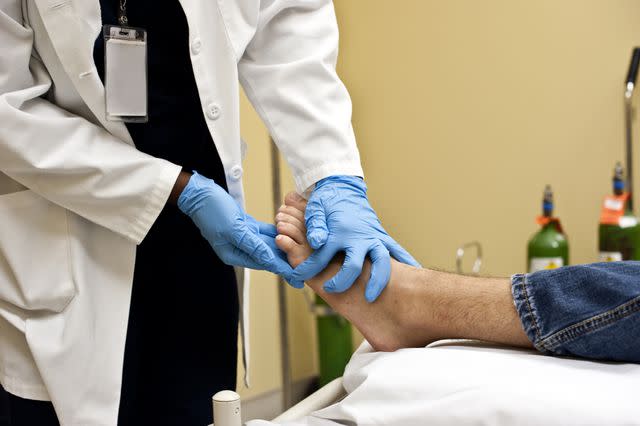What Are Flat Warts?
Flat warts (or plane warts) are caused by viruses, but they are usually harmless.
Warts are small, slightly raised skin growths caused by the human papillomavirus (HPV). Almost everybody gets some form of HPV in their lifetime. It is not always transmitted through sexual contact.
Flat warts are usually harmless. Flat warts are often light brown and can be found on areas of the body that are frequently shaved. However, they often appear on children's cheeks, foreheads, hands, and forearms.
This article discusses more on symptoms of flat warts, causes of and risk factors for flat warts, diagnosing flat warts, other conditions that can look like flat warts, treating flat warts, when to see a healthcare professional, and how to prevent flat warts.

Juanmonino / Getty Images
What Do Flat Warts Look Like?
Flat warts are generally harmless, and they can be spotted by appearance. The following are some signs of a flat wart:
Raised skin with a rough or soft surface
Raised skin shaped like a small (a few millimeters) circle or oval
May be skin-colored, pink, or brown
Flat Warts: Causes and Risk Factors
Flat warts are caused by the human papillomavirus (HPV) and are usually harmless. There are at least 200 kinds of HPV, and while most HPV doesn't cause symptoms, more than 40 million Americans have HPV, that can cause disease. HPV can be transmitted without sexual contact (including to genital areas), including via:
Skin-to-skin contact with someone who has warts or HPV
Skin-to-mucus contact with someone who has warts or HPV
Touching clothing or objects (towels, razors, furniture, etc.) with HPV on it
Sexual contact of any kind
An open cut on the skin
Moist skin or environments
HPV transmission often occurs via sexual contact, and flat warts can be sexually transmitted. However, HPV can also be passed on through:
Sharing objects like razors and towels
Skin-to-skin contact
Skin-to-mucus contact
Diagnosing Flat Warts
Flat warts are diagnosed by their characteristic clinical appearance. A healthcare professional might also diagnose a wart by examining a patient's skin.
Treating Flat Warts
Warts usually disappear on their own. However, the process can take weeks or months. There are treatments available for removing warts but they can re-emerge due to viruses.
People with flat warts on their faces or genitals are advised to avoid over-the-counter medications and to see a healthcare provider for wart removal. Pregnant or breastfeeding people or those with severe diabetes (with nerve damage) are advised to see a healthcare provider before wart treatment or to avoid treatment.
To treat a flat wart, the following treatments could be considered:
Over-the-counter wart removers containing salicylic acid, silver nitrate, and other acids
Cryotherapy: A treatment in which a dermatologist freezes a wart using liquid nitrogen. Side effects may include burning sensations or inflammation.
Imiquimod cream: Used to treat some skin cancers, and it can be used to treat warts. However, they might still need to be removed completely.
Duct tape: Duct tape is a potential at-home remedy for flat warts. To treat a wart with duct tape, cover the wart for six days, soak and file the wart after removing the tape, and then reapply the tape for six more days until the wart disappears.
Increased hygiene: Wearing shower shoes in public shower areas and avoiding sharing personal items (like towels or razors) could help prevent HPV transmission and flat warts.
Flat Warts and Other Diagnoses
Flat warts can mimic other skin conditions, and ruling out other disorders by meeting with a healthcare provider could be necessary. These include:
Skin cancer: Dark spots could be a sign of melanoma or an advanced tumor.
Seborrheic keratosis: A condition that causes benign growths on the skin.
Flat Wart Prevention
Preventing flat warts requires preventing the transmission of HPV. HPV infects almost everyone, and research indicates hygiene might not have an effect. However, some general practices could help lower the risk of transmitting HPV that could cause flat warts, including:
Avoiding sharing personal items like towels or razors
Avoiding contact with another person's warts
Avoiding picking at or scratching a wart
Washing items that come in contact with a wart to avoid spreading it to other parts of the body or other people
Wearing shoes on floors shared with large groups of people, especially if the floor is wet (such as with public showers)
Getting the HPV vaccine: Research indicates it might be possible to prevent and treat warts with the HPV vaccine. It's advised to speak to a healthcare professional before getting the HPV vaccine to treat warts.
When to See a Healthcare Professional
Flat warts should be checked by a healthcare professional to rule out skin cancer. If you are pregnant or breastfeeding or have a chronic condition like diabetes or HIV, it's advised to check with a professional before getting flat wart treatment.
Other symptoms with flat warts that could require medical attention include:
Pus or other discharge
Redness
Bleeding
Pain
Genital warts
Warts not responding to treatment
Change in wart appearance
Compromised immune system
Summary
Flat warts are small patches (about a few millimeters) of raised skin that are usually harmless. Flat warts are caused by the human papillomavirus virus (HPV), which can be transmitted via skin-to-skin contact or by touching objects touched by someone with HPV. Most people will get HPV in their lifetimes, and most will not experience symptoms. In rare cases, diagnosing a flat wart could require ruling out skin cancer with a biopsy. Treating flat warts can include over-the-counter medications containing salicylic acid or cryotherapy.
If you have a compromised immune system or are pregnant or breastfeeding, you should speak to a healthcare professional before seeking treatment. While it's difficult to prevent HPV, some hygienic practices could help prevent the spread.

